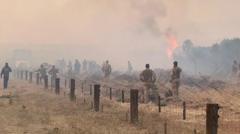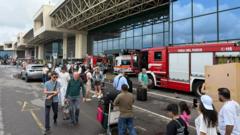The report detailing the investigation into the closure of Heathrow Airport has pointed to a lack of maintenance as the root cause behind the critical failure. A fire ignited at an electrical substation on March 21, resulting in the abrupt shutdown of one of the world's busiest airports for over 12 hours due to a short circuit in a neglected transformer part. The regulatory findings released on July 2, 2025, indicate that the malfunction stemmed from a bushing within the transformer that had not been serviced in almost a decade.
More than 1,000 flights were disrupted during this incident, as the fire led to electrical outages that incapacitated essential safety systems. Reports initially suggested that the outage was linked to a significant fire but did not delve into the causes until this recent publication. The 77-page analysis identified that the issue had been acknowledged as far back as 2018 yet remained unresolved, even when maintenance was postponed the following year.
Regulatory bodies revealed that routine maintenance on the transformer, known as SGT3, last occurred in July 2018, with numerous attempts to schedule further upkeep falling through. This negligence has raised alarm not only among travelers but also airline officials and government leaders, highlighting the fragility of the UK's electrical grid. Prime Minister Keir Starmer expressed his serious concerns during the shutdown, pressing for answers regarding the situation.
In examining the airport's internal power system, the report noted that it was ill-equipped to rapidly utilize energy from unaffected nearby substations during the crisis. The authors emphasized that Heathrow officials had not anticipated the likelihood of a catastrophic power failure, leading to inadequate preparedness for managing such incidents. Their expectation of a resilient electrical network proved misguided; the infrastructure relied heavily on manual switching rather than automatic adjustments to maintain power.
This investigation underscores the urgent need for improved maintenance routines and resilience planning for critical infrastructure, as cities grapple with the challenges posed by aging systems amid increasing climate-related demands.
More than 1,000 flights were disrupted during this incident, as the fire led to electrical outages that incapacitated essential safety systems. Reports initially suggested that the outage was linked to a significant fire but did not delve into the causes until this recent publication. The 77-page analysis identified that the issue had been acknowledged as far back as 2018 yet remained unresolved, even when maintenance was postponed the following year.
Regulatory bodies revealed that routine maintenance on the transformer, known as SGT3, last occurred in July 2018, with numerous attempts to schedule further upkeep falling through. This negligence has raised alarm not only among travelers but also airline officials and government leaders, highlighting the fragility of the UK's electrical grid. Prime Minister Keir Starmer expressed his serious concerns during the shutdown, pressing for answers regarding the situation.
In examining the airport's internal power system, the report noted that it was ill-equipped to rapidly utilize energy from unaffected nearby substations during the crisis. The authors emphasized that Heathrow officials had not anticipated the likelihood of a catastrophic power failure, leading to inadequate preparedness for managing such incidents. Their expectation of a resilient electrical network proved misguided; the infrastructure relied heavily on manual switching rather than automatic adjustments to maintain power.
This investigation underscores the urgent need for improved maintenance routines and resilience planning for critical infrastructure, as cities grapple with the challenges posed by aging systems amid increasing climate-related demands.




















